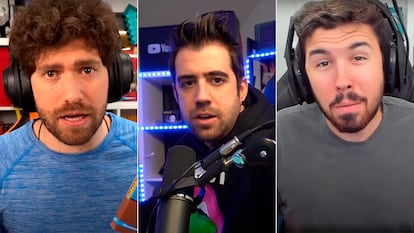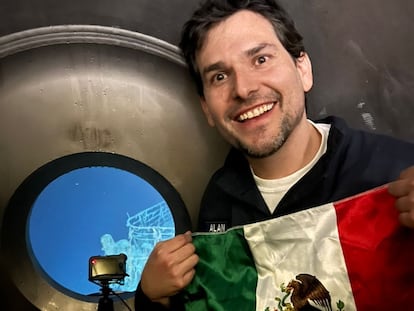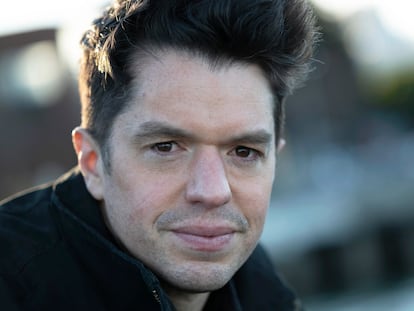‘Being a YouTuber is as hard as being a soccer player’: The abysmal odds of succeeding as a content creator
Spanish researchers reveal just how difficult it is to reach the necessary numbers to live off the most popular video platform in the world

There are 1,050 players in the 42 Spanish First and Second Division soccer teams (if we count 25 players per team). Also in Spain, there are 1,186 YouTubers with more than 500,000 subscribers, which is the approximate figure they need to earn enough money to make a good living just from creating content. That half million is an estimate and depends on many factors (the creator’s main platform, income outside social media, expenses, type of videos), but it serves to illustrate just how difficult it is to achieve a viable, stable job in social media.
“500,000 subscribers guarantee social capital on YouTube and are a good base to accumulate video views,” says Òscar Coromina, a researcher at the Malmö University and the Autonomous University of Barcelona who has been studying YouTube and its economy since 2016. “This figure is also usually equivalent to a significant volume of followers on other platforms, and therefore offers favorable conditions to obtain additional monetization.”
In his latest scientific article, Coromina analyzed where the links that YouTubers place in the video descriptions go. The researchers examined 137 million videos from 153,000 YouTubers who in 2019 had more than 100,000 subscribers. Their goal was to find out what other networks and resources they use in their efforts to accumulate enough income to live: mainly links to other social networks or ecommerce or crowdfunding platforms. Their main finding is that this is a widespread and growing practice: for each of the 137 million videos, there is an average of 4.37 links.
The authors of the article also include a table where they estimate the advertising revenue that YouTube shares with its creators: for every ad, the platform keeps 45% and the creator 55%. In that estimate, they found that creators with more than 10 million subscribers earned, on average, $1.7 million per year; between 1 and 10 million subscribers, $166,000; and between 100,000 and 1 million subscribers, $16,000 per year. “With this kind of research we have seen, for example, that being a YouTuber is as hard as being a soccer player,” says Coromina.
In the lower rungs of those numbers of subscribers, the options for creators must include many different sources of income: “They probably have to support themselves with other things: events, product placements, selling tweets. These people work hard. But for YouTube they are just something else. They have a presence in other networks – they maybe even have another job,” says Coromina. This digital moonlighting is one of the reasons why, despite the similar numbers, it may even be easier to become a professional soccer player than a YouTuber.
The authors were taken aback by the low figures they found, particularly in a country like Spain, with the third most spoken language in the world. They wanted to look at just one country to better understand how a global platform like YouTube works, as its global figures are difficult to compare: “We were surprised that the number of professional creators was so low,” says Adrià Padilla, a researcher at the Autonomous University of Barcelona and Coromina’s collaborator. “It is striking because Spanish-language content has more visibility, due to the number of Spanish speakers in the world. Although we have not studied other countries in depth, everything indicates that Spain has a more developed professional structure than other countries of similar sizes but with a language with fewer speakers,” he adds.
Although the figures are not exact, they give an idea of the challenge and the effort involved in working as a YouTuber. TheGrefg is one of the most important YouTubers in Spain. He created his channel in January 2012; a few months ago he explained, in a podcast, how difficult it was at the beginning, at a time when the competition was much smaller: “You devote a lot of hours to it before you can consider it a job,” he said. “Some people can see you, but you need a lot of people to see you for it to become a job. It took two years or more to get to that point, when I already had 200,000 or 300,000 subscribers,” he adds. There is a lot of previous invisible work: “My channel has videos and videos and videos with very few visits, until I began to seize the opportunity every time a new game came out; I was the first to upload it and people liked watching me play and comment and so, little by little, I built up,” he explained.
[elRubius, who with more than 40 million subscribers is still the leading YouTuber in Spanish, is not on this list because his channel is set as “global” and does not appear when collecting national data. That is also the reason why this list includes channels in English whose location must be set to “Spain.” The authors give no answer regarding the choice of location, beyond commercial strategies.]
A YouTuber would probably take years to reach adequate numbers: “If we take the figure of 500,000 subscribers as a reference, we see that, on average, these channels require about six years to achieve it, which works both globally and for Spain,” says Padilla. Those six years are an average, although some get there earlier: “Very few have vertiginous growth,” he adds.
The problem with those six years is not just the time; it is, above all, the pace of production that must be maintained. “With our research we have seen that a creator publishes an average of 25 13-minute videos a month. In six years, that would be 1,800 videos and 390 hours,” explains Coromina.
‘Mom, I want to be a YouTuber’
These data have many consequences for those who think about YouTube as an aspirational profession. Young people who consider it should know that they are entering an extremely demanding environment: “YouTube has set up a media system that competes with the traditional one,” says Coromina. “In the US there are more people who want to be an influencer than an astronaut. For a 16-year-old boy, getting paid for playing video games and making a living out of that is an aspiration. The mythification of the YouTuber is built on that,” he adds.
Getting to the point where theGrefg is now requires many hours of aspirational labor. It is a system similar to that of traditional media: the so-called “hopeful work,” which basically means being a contingent worker for years with the hope of obtaining a position years later. However, there is a substantial difference with the media industry: it is easier to reach the goal and get a job there, because there are more positions. Spain, which has a global language, can currently maintain only a limited number of YouTubers.
Some creators, like Ibai Llanos, already have teams that amount to small producing houses, but the differences with large media conglomerates are still wide. “When we think of YouTube, we criticize the schools of journalism a lot, but if we compare them, the schools are a more efficient system because they have a higher level of employment. YouTube is more like the idea of Uber, that sort of precarious economy. If you want to be successful, it’s easier to study a career than to try YouTube,” says Coromina. “The media must vindicate themselves. If you compare the number of jobs generated by traditional media such as television, press or radio, with YouTube, the difference is enormous,” he adds.
But that is not the only problem with relying on a platform like YouTube for revenue. As many creators know, you are in their hands without any protection; a change of mood in Silicon Valley prompts new terms of service and sinks the revenue for several channels. Jordi Wild, with 3.97 million subscribers, is one of the largest channels in Spanish. A few weeks ago, he explained that YouTube “punished” his videos for containing insults, and he could barely monetize them. And the problem is not only the change, but also the difficulty in finding out what is going on and solving it.
Despite his nearly 4 million subscribers, it took days to get someone from YouTube to respond. The platform knows that if Jordi Wild leaves, others – just as interesting, if not more – will come. The platform does not lose much, nor does it have to indulge anything. “YouTube has very bad communication. It doesn’t tell you: ‘You are an important channel, you move a lot of people and bring a lot of money; we noticed a drop in your income, this is what’s going on.’ Nobody tells you anything and when you ask – I asked a lot, but they didn’t give any plausible explanation,” explains Jordi Wild, who threatened to leave the platform.
“I am a guy who has been on this platform for ten years,” Jordi Wild continues. “I have 70 to 100 million monthly views. That’s a lot of money. I cover good topics; I have brought scientists, writers, politicians, people who make YouTube great.” On Twitter, he said that he was looking for alternatives. He asked for options and had conversations with other platforms. “I can’t keep being mistreated by YouTube. There’s only so much I can take. Other places want me, even audio platforms. However, if YouTube behaves well, that is where I feel most comfortable,” he points out. In the end the problem had been caused by a t-shirt with the word “fuck” and a book titled Así es la puta vida (Such is this fucking life). Wild himself reflects: if you have these problems at the top, what hope do the rest have?
In the case of Jordi Wild there was no clear change in policies. That has happened, however, with the children’s channels, which were unable to continue monetizing after YouTube made a unilateral decision. “We have not looked at specific cases, but we have seen that among the channels that in theory are well positioned in their path towards professionalization (more than 100,000 subscribers), there is a very high number who no longer produce content or who have deleted their content. These inactive channels respond to many causes, but they make us think that there are many creators who leave their channels due to changes in advertising policies, not being able to stabilize a professional career or even for mental health reasons. Many well-known YouTubers [...] have taken breaks or left completely after being burnt out. We are talking about 9% of all the channels with more than 100,000 subscribers,” concludes Coromina.
Sign up for our weekly newsletter to get more English-language news coverage from EL PAÍS USA Edition
Tu suscripción se está usando en otro dispositivo
¿Quieres añadir otro usuario a tu suscripción?
Si continúas leyendo en este dispositivo, no se podrá leer en el otro.
FlechaTu suscripción se está usando en otro dispositivo y solo puedes acceder a EL PAÍS desde un dispositivo a la vez.
Si quieres compartir tu cuenta, cambia tu suscripción a la modalidad Premium, así podrás añadir otro usuario. Cada uno accederá con su propia cuenta de email, lo que os permitirá personalizar vuestra experiencia en EL PAÍS.
¿Tienes una suscripción de empresa? Accede aquí para contratar más cuentas.
En el caso de no saber quién está usando tu cuenta, te recomendamos cambiar tu contraseña aquí.
Si decides continuar compartiendo tu cuenta, este mensaje se mostrará en tu dispositivo y en el de la otra persona que está usando tu cuenta de forma indefinida, afectando a tu experiencia de lectura. Puedes consultar aquí los términos y condiciones de la suscripción digital.
More information
Archived In
Últimas noticias
ICE raids trigger school absenteeism and traumatize children: ‘They have been forced to leave their childhood behind’
The life of a delivery driver in China: ‘Many people don’t know how an order can arrive at their home in just one day’
Maude Apatow, from acting in ‘Euphoria’ to directing: ‘There are many films that you can tell weren’t written by someone young’
Families demand repatriation of bodies of Colombians who died in Ukraine: ‘This war is a slaughterhouse for foreigners’
Most viewed
- Christian Louboutin: ‘Young people don’t want to be like their parents. And if their parents wear sneakers, they’re going to look for something else’
- US sanctions against jailed cartel leader ‘El Marro’ highlight Mexico’s lack of control over its prisons
- Cartels in Mexico take a leap forward with narco-drones: ‘It is criminal groups that are leading the innovation race’
- Liset Menéndez de la Prida, neuroscientist: ‘It’s not normal to constantly seek pleasure; it’s important to be bored, to be calm’
- ‘El Limones’ and the growing union disguise of Mexican organized crime











































